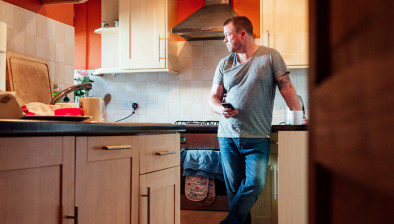England: Proportion of people facing homelessness with physical ill health and disabilities on the rise

The proportion of households facing homelessness with physical ill health and disability needs in England has increased markedly over the past five years, new analysis has revealed.
Studying the UK Government’s most recent statutory homelessness figures, Crisis has found that 62,040 households with physical ill health and disability needs faced homelessness in 2023/24. This represents around a fifth (19%) of 324,990 total households facing homelessness. In 2018/19, there were 35,860 households facing homelessness with these support needs, representing around an eighth (13%) of total households.
Crisis also found that quarterly data updates show that this proportion has continued to rise, with more than 21% of households facing homelessness expressing physical ill health and disability as a support need between October and December 2024.
In real terms, there has been a 73% increase in the number of households with these support needs who approached their council for homelessness support between 2018/19 and 2023/2024.
Why is this happening?
This increase could be attributed to some, or a combination, of the following factors:
- There is a huge lack of suitable adapted housing in the private rented and social rented sectors. This is forcing people with existing health conditions and disabilities into homelessness
- The cost of living crisis is making it harder for people in the most vulnerable situations to maintain their rents, and/ or secure good health
- Access to healthcare services, mainstream NHS services and wider support is becoming more difficult due to increased pressures on local government and NHS funding
- Accessing healthcare is harder still for people facing homelessness or housing precarity. Two thirds of GP practices in a London ‘mystery shopper’ exercise refused to register people without a fixed address.
- People with physical health conditions and disabilities often find it more difficult to find somewhere to live, because of a significant lack of accessible and truly affordable housing across England. A 2023 report by the Levelling Up, Housing and Communities Committee found that people with disabilities have been placed on decades-long waiting lists for social housing which is accessible for their needs.
With councils across England struggling to fund new social and affordable housing, Crisis is concerned that people with health needs will be placed in even more vulnerable situations. Over the past 10 years, there has been a net loss of more than 180,000 social homes, as these homes are sold off or demolished at a faster rate than they are built.
Furthermore, it now appears that fewer social homes are going to households with a disability than before. Of new social housing lettings in 2023/24, 16% were to households with a disability or access-related housing need (a total of 34,912 households). This fell from 20% in 2022/23 (39,866 households), decreasing for the second year in a row. This means that while the overall number of new social tenancies increased, almost 5,000 fewer households with disability or access-related housing need were accommodated in social housing in 2023/24 compared to the previous year (MHCLG, 2025).
In the private sector, disabled people have faced significantly higher asking prices for accessible homes and, in some cases, landlords have denied permission for adaptations to make properties accessible (both cited in a LUHC committee report on Disabled people in the housing sector, March 2024). Circumstances such as these can leave disabled people without somewhere suitable to live and at risk of homelessness.
More widely, a recent report from Crisis and Health Equals revealed the extent of housing affordability in England. It found that just 2.5% of private rented properties listed in England are affordable for people needing housing benefit. This is forcing people into often unsuitable and poor quality temporary accommodation that can be harmful for their health or exacerbate existing health concerns.
What can or should be done?
To address this concerning trend, Crisis is calling on the Westminster Government to do five things:
- Build 90,000 social homes a year, as part of the government’s 1.5 million target by 2029, making sure this includes adapted, adaptable and accessible properties via the Inter-Ministerial Group on Homelessness and Rough Sleeping, review policies across government and their impact on homelessness for the upcoming homelessness strategy, including the proposed changes to PIP
- Reverse the real terms cut that it is making to housing benefit, which has just been frozen at its current level until 2026, and make sure Local Housing Allowance (housing benefit) covers at least the bottom 30% of private market rents
- Improve access to healthcare by reforming General Practice funding to ensure better preventative services for people facing homelessness, and providing more specialist support in hospitals and to support safe discharges
- Seize a once in a generation chance by publishing an ambitious, cross-departmental strategy to end homelessness and ensure the forthcoming long-term housing strategy and 10-year NHS plan include a shared outcome on ending homelessness.
Matt Downie, chief executive of Crisis, said: “These figures are really concerning. We know that homelessness often exacerbates or creates health issues – whether by forcing people to live in mouldy and damp rooms, or by making it more complicated to access healthcare. The increases we are seeing are likely to mean more hardship, and more pressure on already overstretched councils.
“There have been some promising commitments from the Westminster Government, including around social housing. Yet the recent decision to freeze housing benefit will make it harder for people to find somewhere to live, and we are still losing more social homes per year than we’re building. Changes to PIP will make it harder for people with disabilities to leave homelessness behind.
“After years of underinvestment, we need ministers to provide renewed security and stability for people across the country. This means showing the political will to build 90,000 new social homes per year, over the next five years, unfreezing housing benefit and funding the right support for people contending with the threats of poverty and homelessness.”
Alex Bax, chief executive of Pathway, added: “The picture these figures paint is shocking but sadly not surprising. We know that poor health is both a cause and a consequence of homelessness, but that our health service is too often unable to provide the care that people facing homelessness need. This means people being turned away from GP surgeries, facing late diagnosis of serious illnesses like cancer, and unable to manage chronic conditions like diabetes, all while struggling with homelessness.
“It is time for bold action to treat poor health and homelessness in the joined-up way that these figures show is so desperately needed. The Government’s 10 Year NHS plan, along with its homelessness strategy, is an opportunity to do this, preventing illness by improving GP access for people facing homelessness, making sure that homelessness is counted in NHS data and providing the right specialist healthcare in hospitals and the community.”








